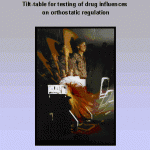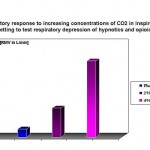Usefulness of the methods
Some side effects, e.g. as changes in vigilance and performance, orthostatic dysregulation, respiratory depression, or anticholinergic and cholinergic effects, are typical for drugs or even drug groups acting on the CNS and should be investigated and quantified for labelling and regulatory purposes. With respect to these side effects (and their intensity and frequency) new agents often show an advantageous profile. Showing such superiority may also be of great interest. HPR offers methods which fulfil these purposes.
Methods presented in separate papers
The following methods which are frequently relevant for the measurement of side effects in CNS are presented in detail on (extra) pages:
- Measurement of vigilance and CNS performance
- Dynamometry, surface EMG
- Tremor measurement
- Measurement of drug-ethanol interactions
Further side effect tests:
Tilt table test:
 The tilt table test is used to determine the cardiovascular regulation to postural changes. Non-invasive hemodynamic parameters such as heart rate, systolic and diastolic blood pressure, venous pressure, pulse wave transmission time as well as relative volume changes in the lower extremities (with venous occlusion plethysmography) can be recorded and analysed. With this test system we have documented impressive orthostatic dysregulations after the administration of antihypertensives and benzodiazepine-anxiolytics and hypnotics and improvements after administration of alpha- and beta-ergic drugs (antihypotensives).
The tilt table test is used to determine the cardiovascular regulation to postural changes. Non-invasive hemodynamic parameters such as heart rate, systolic and diastolic blood pressure, venous pressure, pulse wave transmission time as well as relative volume changes in the lower extremities (with venous occlusion plethysmography) can be recorded and analysed. With this test system we have documented impressive orthostatic dysregulations after the administration of antihypertensives and benzodiazepine-anxiolytics and hypnotics and improvements after administration of alpha- and beta-ergic drugs (antihypotensives).
Hypercarbia:
This set-up was developed for the investigation of CNS and pain compound-induced potency of respiratory depression. The subject inhales air which is step-wise enriched with up to 4 % CO2. The respiratory volume as the dependent variable, determines the respiratory response (RMV, see figure left). The technique has successfully been used for measuring the effect of benzodiazepines, hypnotics and centrally acting analgesics on respiratory regulation.
The subject inhales air which is step-wise enriched with up to 4 % CO2. The respiratory volume as the dependent variable, determines the respiratory response (RMV, see figure left). The technique has successfully been used for measuring the effect of benzodiazepines, hypnotics and centrally acting analgesics on respiratory regulation.